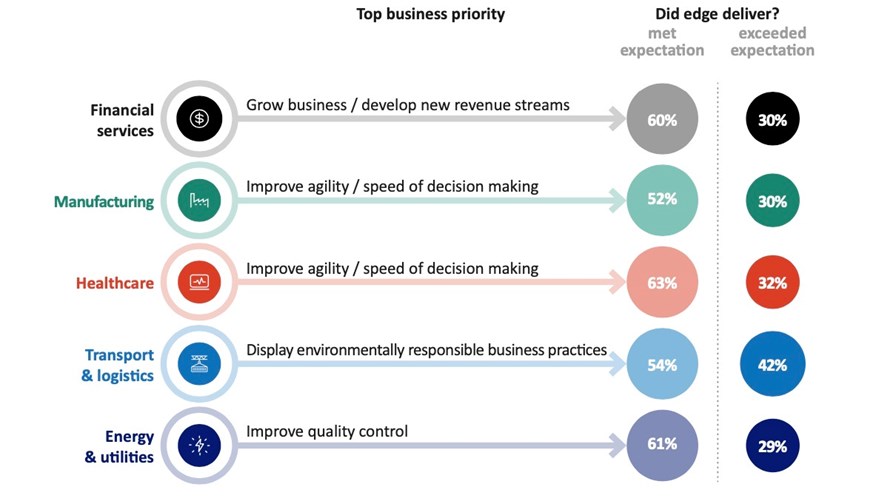
Priority outcomes achieved by edge deployers (Source: 2023 Omdia NTT Edge Advantage Survey)
- Edge computing is playing a meaningful role in many enterprise IT strategies
- NTT report finds many expectations have been exceeded for early adopters
- But there are also major concerns about the ability of current edge platforms to support future application requirements
- Might private 5G remedy some of those concerns?
Edge computing is turning out to be a double-edged sword for enterprises, many of which are already enjoying benefits from early deployments yet are concerned about associated technology trends and future application support issues that could scupper their plans, according to a report from NTT Ltd, the enterprise services unit of giant Japanese telco NTT Group.
The Edge Advantage report is based on an industry survey conducted by NTT Ltd and research house Omdia, which between them spoke to 621 “current enterprise investors in edge solutions” representing five industry verticals – financial services, manufacturing, healthcare, transport and logistics, and energy and utilities – from 17 countries.
The general survey result trends are positive, with 80% of respondents saying their edge investment expectations have been met or exceeded, as the graphic above shows.
It’s clear also that the edge journey for these companies is still at an early stage but is set to ramp up quickly (perhaps fuelled by the hype around generative AI), with more than 80% expecting their dependency on third-party edge services set to grow over the next two years.
Enterprises that have already invested in edge capabilities are “benefitting from digital technologies that accelerate data-driven decision-making, secure physical and virtual assets, and control sustainably resilient operations,” according to NTT Ltd.
And nearly all of these investors in enterprise edge resources, some 94%, are working with partners, as opposed to trying to go it alone. They would, however, like a single edge partner that can help them with their evolving needs.
Critically, given the enormous volumes of data these companies expect to be shunting in and out of their edge computing platforms, low-latency network support is regarded by most as of great importance, with 88% of respondents citing 5G as “an important enabler” of their plans.
This paints a very positive picture for companies such as NTT Ltd, which is marketing 5G private networks as well as edge-as-a-service offerings.
But it’s not all roses and sunshine: The survey also found that nearly 40% of those planning edge deployments are “concerned that current infrastructure capabilities won’t be able to support the promise of edge,” while many “fear that the rapid pace of technology evolution could cost them in the long term.”
NTT Ltd notes: “Current adopters see the fragmented management of compute, connectivity and IoT [internet of things] devices as a hindrance to realising the potential of edge,” with investments in new or upgraded networks regarded by the report authors as the panacea.
The question now is whether private 5G networks and edge-as-a-service can alleviate such concerns. While the industry jury is still out on that, NTT Ltd, at least, has already come to a verdict and, not surprisingly, it fits neatly with its portfolio of offerings.
“The growing need for faster processing and a distributed digital architecture is creating increased pressure on networks and infrastructure capabilities, driving both accelerated adoption of private 5G and edge,” stated Shahid Ahmed, EVP of new ventures and innovation at NTT Ltd. “Achieving the edge advantage will require end-to-end solutions with holistic management and uncompromising accountability. Only through utilising these solutions can enterprises gain instant access to data, where it is generated or collected, with near zero latency, and harness it to drive powerful business outcomes.”
So there’s the NTT pitch.
Putting that view to one side for the moment, though, there does appear to be some empirical evidence from the survey results that point to some interesting trends.
For example, despite the recent loud industry noise around private 5G, deployments have largely been limited to early adopters, with most private wireless networks using 4G due to its maturity and availability. But the survey results suggest that the “investment balance is changing – only a fifth of enterprises deploying edge within the next 12 months plan to use private 4G/LTE, compared to one-third budgeted to invest in private 5G. While they are a small cohort today, current private 5G users tend to record better outcomes than enterprises using older LTE private networks with edge, or no private networks at all. They report achieving more benefits, including integration of [the] network with edge (57% versus 35%), better security with localisation (51% versus 37%), better analytics (46% versus 30%), and better applications performance (43% versus 31%). These are highly promising results that others will want to replicate or exceed,” conclude the report’s authors.
The report also contains a number of interesting insights into enterprise edge trends and potential strategic options for enterprises, and as you’d expect, artificial intelligence is playing its part.
“According to organisations that have already deployed [edge], the top reasons to invest are to automate and add AI in business processes, and to gain real-time access to data,” the report notes, and it’s hard to see how generative AI won’t accelerate edge investment decisions for at least the rest of this year.
- Ray Le Maistre, Editorial Director, TelecomTV




